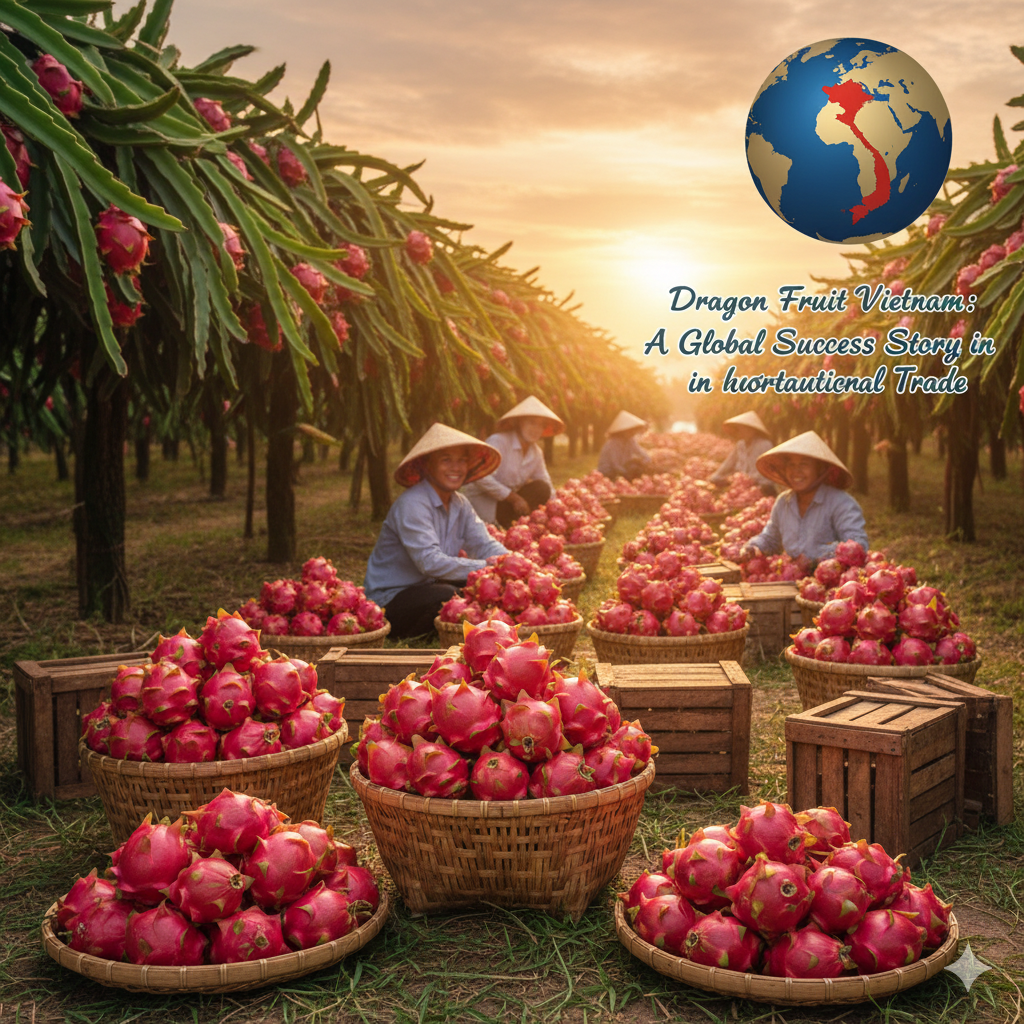Dragon fruit Vietnam has become one of the most recognized agricultural success stories in Asia’s fruit export market. Over the last two decades, Vietnam has risen from being a modest regional producer to the world’s largest exporter of dragon fruit, shipping this vibrant fruit across Asia, Europe, and the Americas. Despite challenges from market volatility and regulatory shifts, the dragon fruit Vietnam export industry continues to thrive, backed by strong production capacity, diversified markets, and strategic policy support.
According to the Vietnam export data, dragon fruit exports were valued at $600 million in 2024, marking a slight 1% dip from the previous year. Yet, this modest decline hides a deeper story — one of adaptation, diversification, and transformation within Vietnam’s fruit sector.
The Heartland of Vietnam’s Dragon Fruit Production
The backbone of the Vietnam dragon fruit industry lies in three key provinces — Binh Thuan, Long An, and Tien Giang. Together, they contribute nearly all of Vietnam’s 55,000 hectares of dragon fruit cultivation and produce over 1 million tons annually.
-
Binh Thuan Province is often called the “capital of dragon fruit Vietnam,” accounting for nearly 60% of total production.
-
Long An Province is known for both red- and white-fleshed varieties, while Tien Giang boasts modern, certified farms that meet global quality standards.
Approximately 80–85% of this production is exported each year, showing just how deeply the livelihoods of farmers and exporters depend on international demand.
Top Export Markets for Vietnam Dragon Fruit
As per the Vietnam customs export data, China remains the largest market for dragon fruit Vietnam export, accounting for around 80% of the total export value — approximately $480 million in 2024. Its proximity and consumer preference for dragon fruit make China a natural trading partner.
However, Vietnam has made remarkable progress in reaching new destinations. The United States, India, United Kingdom, Germany, UAE, South Korea, Australia, Netherlands, and New Zealand now form a diversified global portfolio.
Key export highlights:
-
India: $30 million (5%) – Rapidly growing market driven by rising middle-class demand.
-
USA: $24 million (4%) – Strong growth following compliance with U.S. phytosanitary rules.
-
UK & Germany: $30 million combined – Rapidly increasing demand in European supermarkets.
-
UAE & Middle East: Favor premium red-fleshed varieties.
This diversification signals a strategic shift — Vietnam exports are no longer overly dependent on one single market, thereby reducing vulnerability to regional policy shifts.
Vietnam Dragon Fruit Export Performance Over the Years
The export performance of dragon fruit Vietnam has seen fluctuations over the past decade. After peaking at $1.3 billion in 2018, the value of exports gradually stabilized between $600–700 million annually.
Here’s a quick timeline of Vietnam dragon fruit export performance:
| Year | Export Value (USD) |
|---|---|
| 2014 | 850 million |
| 2015 | 900 million |
| 2016 | 1 billion |
| 2017 | 1.15 billion |
| 2018 | 1.30 billion |
| 2019 | 1.05 billion |
| 2020 | 900 million |
| 2021 | 800 million |
| 2022 | 650 million |
| 2023 | 620 million |
| 2024 | 600 million |
Notably, dragon fruit Vietnam reclaimed its position as the top fruit export in early 2025, surpassing durian, whose shipments declined due to new Chinese import protocols.
Export Prices, Certifications & Quality Standards
In early 2025, farm-gate prices for Vietnam dragon fruit ranged from VND 23,000 to 35,000/kg (USD 0.90–1.37) for high-grade fruit, while lower-grade varieties sold for VND 10,000–15,000/kg.
Vietnam’s success in maintaining quality comes from its robust certification system:
-
Over 9,500 hectares are VietGAP-certified.
-
Around 450 hectares meet GlobalGAP standards, opening access to high-end markets like the EU, US, and Japan.
-
548 planting area codes and 260 packing facility codes ensure traceability and compliance.
Such certification-driven quality control allows Vietnam exports to command premium prices and compete with rivals in global markets.
Challenges Facing Vietnam’s Dragon Fruit Exporters
Despite its success, dragon fruit Vietnam export faces multiple structural and environmental challenges:
-
Regulatory Barriers – China now mandates rigorous lab testing for chemical residues. Similarly, the EU has tightened pesticide residue limits, raising compliance costs.
-
Price Volatility – Oversupply during peak harvest seasons leads to price drops that hurt farmers’ profitability.
-
Logistical Limitations – Border congestion and limited cold-chain infrastructure delay shipments.
-
Overdependence on China – Heavy reliance on a single market exposes the industry to trade disruptions.
-
Climate Risks – Droughts, especially under El Niño conditions, threaten yield stability in provinces like Binh Thuan.
Opportunities & Strategic Growth Insights
The future of dragon fruit Vietnam lies in strategic adaptation. Here’s how Vietnam can strengthen its global position:
1. Market Diversification
Expanding into India, Europe, and North America can stabilize exports. These markets value food safety and sustainable sourcing, areas where Vietnam is investing heavily.
2. Value-Added Products
There is growing potential for processed items like dried dragon fruit, juices, powders, and freeze-dried snacks. Such products extend shelf life and add value beyond fresh exports.
3. Branding & Marketing
Vietnam can position Vietnam dragon fruit as a premium tropical fruit, emphasizing sustainability, freshness, and origin authenticity — similar to Thailand’s durian branding success.
4. Investment in Logistics
Modern cold-chain systems and maritime routes will reduce spoilage and enhance access to distant Western markets.
5. Sustainable Agriculture
Adopting water-efficient irrigation, organic fertilizers, and pesticide reduction programs can align with global sustainability goals, attracting eco-conscious buyers.
Forecast for 2025 and Beyond
If diversification and infrastructure improvements continue, dragon fruit Vietnam export earnings could exceed $800 million by the end of 2025. The country’s export map will continue to shift:
-
China will remain dominant but may gradually lose share as domestic production rises.
-
India and the Middle East will emerge as steady, growing markets.
-
Western markets (EU, US) will expand rapidly if Vietnam maintains certification and compliance momentum.
Role of Vietnam Trade Data Provider in Export Growth
Reliable data insights are essential for exporters and policymakers. A Vietnam trade data provider plays a vital role in offering verified, real-time insights into shipment trends, pricing, and market shifts. Businesses can use this data to identify new buyers, understand competition, and forecast demand accurately.
Platforms like VietnamExportdata by TradeImeX deliver comprehensive datasets covering Vietnam exports, shipment analytics, and company directories for exporters and importers. Access to such verified data supports informed decision-making and helps businesses expand into new global markets.
Conclusion
The story of dragon fruit Vietnam exemplifies how agricultural innovation, trade diversification, and data-driven strategy can transform a nation’s export landscape. From humble beginnings to a global leader, Vietnam’s dragon fruit journey is a model of resilience and adaptability.
However, sustaining this success requires continuous investment in certification, branding, and technology — supported by reliable information from a Vietnam trade data provider.
As the world’s appetite for healthy and exotic fruits continues to grow, Vietnam dragon fruit stands poised to remain a flagship product in the country’s export portfolio — symbolizing not just trade success, but also the spirit of modern Vietnamese agriculture.



